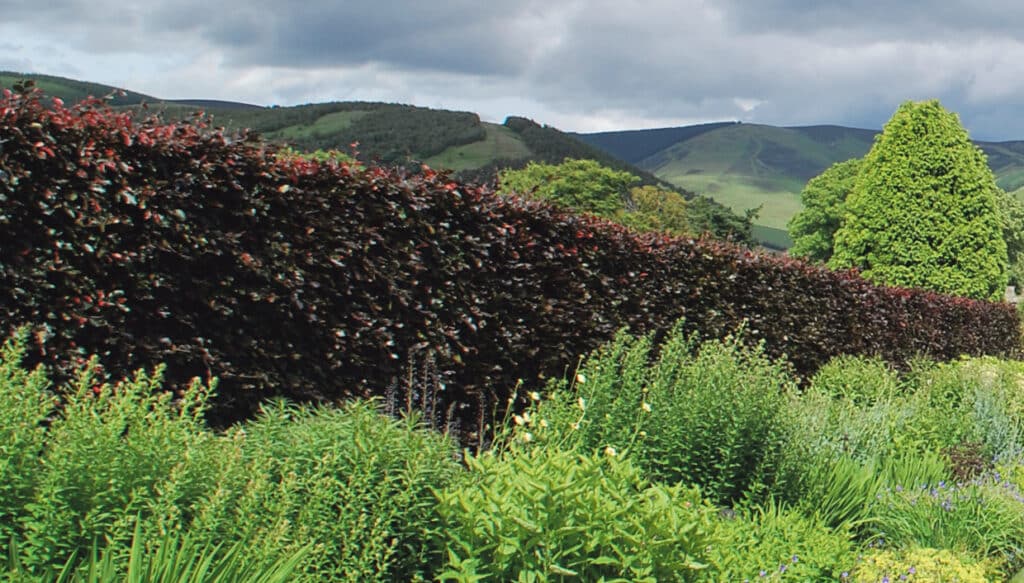“The best time to plant a tree was 20 years ago. The second best time is now.” Chinese proverb
What does the term ‘Bare root’ mean? Put simply, it means plants that have been grown in open ground, then dug up for despatch and planting during the dormant season. They are called ‘bare-root’ plants, as they are supplied with no soil around their roots. November to March is the ideal time to plant bare-root plants. If your land is sheltered, I recommend planting as early in the season as possible to allow the roots time to establish over the winter months. Having strong roots will allow the plants to take up more water and nutrients as well as supporting new growth. In exposed or particularly wet sites, it is best to wait until February or, at the latest, March to plant. In doing so, this will avoid most storms, which can cause plants to become loose in the soil, and water logging around the roots, which can cause root rot or soil compaction during planting. As well as saving money, you will often find a much wider selection of varieties and sizes available as bare-rooted trees and shrubs.

Once you have decided on a suitable location to plant, the next step is to decide what varieties to plant. For many gardeners, this is the most difficult part of the process. Here at Deelish Garden Centre during the bare root season we have thousands of bare root plants to choose from. As many of the plants are dormant and do not have any leaves to distinguish them from each other, it can look a bit overwhelming having to choose between them. To help our customers (and staff) to find the right plant for the right spot, we have divided them into a few groups; Trees, Hedging, Conifers, Fruit trees and Fruit bushes.
How do you picture the planting site in five, 10 and 50 years time? Do you plan to grow wood for burning, fruit trees and bushes for eating, a hedge for shelter and privacy or just want to provide habitat for wild life? Choosing a mix of fast growing trees to be gradually thinned over the years with slower growing hardwoods planted between them is a great option if you are unsure exactly what to choose but just want to start planting. Many gardeners are very keen to plant native trees and shrubs in hedgerows or mass plantings to encourage various wildlife and pollinators and the bare root season offers the best time to do this type of planting. Here at Deelish Garden Centre, I have noticed that forest gardening and permaculture plantings have become really popular over the last few seasons, and both are options that are of great interest to me personally. A garden can be beautiful as well as growing useful plants in terms of food, fuel, shelter, building materials, improving soil, and growing your own medicine! Dividing your garden into various layers from the soil to the tops of your highest trees maximises your growing area while creating a diverse environment for a huge range of creatures that will maintain a healthy balance in your garden without the need for unnecessary pesticides, herbicides and artificial nutrients.
Hedging plants are one of our most popular choices during the bare root season. It is the most cost effective time to plant a hedge, as we can supply some plants for as little as 60 cent each! There are many options to choose from including edible wildlife hedges, native hedges, costal hedges, formal hedges, shady hedges, windy hedges to name just a few. We can also offer farmers and gardeners Irish grown native plants that qualify for government planting grants. We can help with this from start to finish and supply all the paperwork needed to receive the grant.
The next step is to examine the site and ground where you plan to plant. Is it windy? If so which direction does the wind usually come from? Have a look at any other trees in the area to see if they have been blown in any particular direction. Is the ground wet? Dig a few testing holes before planting, if these fill with water and do not drain away, there may be drainage issues. Is the soil deep and fertile, heavy clay or perhaps only a thin layer of good topsoil. Digging a few test holes before choosing your plants will show you a lot about your own soil conditions.
Listed below are a few of my favourite choices for various situations. Visit us at Deelish Garden Centre to hear about other options and the best choices for your own situation.
Many of our customers from Cape Clear Island swear by the Italian Alder (Alnus Cordata) for windy conditions. It grows quickly into an attractive upright tree suitable along driveways. It can be coppiced (cut to ground level) like the native common Alder and also grows well in heavy wet soil while fixing nitrogen in the soil, improving the soil quality and drainage over the years. If drainage is an issue, there are many types of Willow that do not mind wet conditions and can quickly supply useful material for basket weaving or be planted to make living structures such as domes and tunnels. Hawthorn will also take windy conditions and, as well as being our most popular native hedging choice, will grow into a beautiful small tree producing masses of small white flowers in late spring. Rugosa roses (pink, white and red) and Blackthorn are good choices for a windy site, producing flowers and fruit. Be aware that they will send up suckering shoots in following years after planting and need plenty of space to do this, as they can quickly overgrow other plants in a mixed hedge. In my opinion, Green Beech makes one of the nicest formal hedges but is also one of my favourite hardwood trees. We also supply Copper Beech, which is slower growing but in time also makes one of the nicest formal hedges. If you are worried your soil may be too wet for a Beech hedge then Hornbeam makes a great alternative choice for heavy soils.
Mountain Ash (not related to common ash) has to be one of the best choices for windy sites and shallow soil. It produces large, flat heads of numerous creamy-white five-petalled flowers in May and June and these heads become the familiar clusters of red berries in autumn when on a good year, it also has amazing leaf colour. What woodland planting would be complete without some plantings of Oak? There are two native Oak species in Ireland, Quercus petraea or Sessile Oak will grow in thin acidic soil, often found in mountains and sometimes right to the edge of the sea in sheltered spots. Pedunculate Oak (Quercus robur) is the less common of the two native Irish oak species. You can distinguish it from Sessile oak by looking at its acorns – pedunculate oak produces acorns on stalks. This type of Oak grows into the huge specimens, often found on estates and woodlands. We also supply Red Oak (Quercus rubra) and Pin Oak (Quercus palustris) both trees noted for their shape and brilliant autumn colour, which would make an excellent addition to any garden or forest.
For flowering trees and hedging, we recommend various options including Flowering currants, Bird cherry, June berry, Tulip tree, Elder and wild Roses to name a small selection. The bare root season is also the best time to plant some of the more common conifers, which can provide foliage and shelter in the winter when most other trees have lost their leaves. Yew and Scots Pine are two of the three Irish native conifers (the third is Juniper) and well worth considering while planning any native plantings. Yew can also be used for formal evergreen hedging, as well as planted as specimen trees, in fact, the oldest living trees in Ireland are Yew. Although Sitka spruce has gotten a lot of bad attention over recent years due to its overuse in forestry plantations (nearly half of all forestry in Ireland and over 300,000 hectares), it is able to grow in exposed sites with heavy acidic soils where other trees will not be able to grow and gives very fast returns of timber from the time of planting. Larch is also a wise choice for its fast return of quality timber.
The list above is only a small selection of what is currently available during the bare root season at Deelish, and we are currently getting fresh deliveries every few weeks to keep up to demand. Another huge group of plants available during the bare root season are fruit trees and soft fruit. I plan to write another article for this group, as there are so many options to choose from! Feel free to visit us at Deelish Garden Centre and we will help you choose that tree you should have planted 20 years ago! In the meantime, remember gardening doesn’t have to cost the earth, especially in the bare root season.



